Effect of Different Plant Communities on Fine Particle Removal in an Urban Road Greenbelt and Its Key Factors in Nanjing, China
Abstract
1. Introduction
2. Materials and Methods
2.1. Study Area
2.2. Plant Community Description
- Coniferous tree communities, including A2 Cedrus deodara (Roxb.) G. Don;
- Evergreen tree communities, including B1 Malus halliana + Cinnamomum camphora + Osmanthus fragrans + Acer palmatum and B5 C. camphora + Ginkgo biloba + A. palmatum;
- Mixed broadleaf and coniferous trees, including B2 C. deodara + C. camphora and B4 O. fragrans + Phyllostachys edulis + Magnolia grandiflora + Zelkova serrata + Carya illinoinensis + Prunus serrulata;
- Mixed deciduous and evergreen trees, including A4 Metasequoia glyptostroboides + Carya illinoinensis + P. serrulata;
- Deciduous trees, including B3 Styphnolobium japonicum + P. serrulata;
- Mixed evergreen and deciduous trees, including A5 C. camphora + G. biloba, A6 Sapindus saponaria + Prunus cerasifera. “Atropurpurea” + C. camphora + G. biloba, B6 P. cerasifera “Atropurpurea” + G. biloba + Cornus wilsoniana + Albizia julibrissin + C. camphora, A7 Koelreuteria paniculata + Photinia serratifolia + C. camphora + Platanus acerifolia, B7 Koelreuteria paniculata + O. fragrans + Lagerstroemia indica + P. serrulata + Nerium oleander + Prunus persica;
- Blank control group, including square A3 and lawn A1 Cynodon dactylon.
| Street | Site | Street Tree Greenbelt Species |
|---|---|---|
| Mufu South Road | A1 | Cynodon dactylon |
| B1 | Malus halliana + Cinnamomum camphora + Osmanthus fragrans + Acer palmatum − Photinia serratifolia + Euonymus japonicus “Aurea-marginatus” + Loropetalum chinense var. rubrum + Ligustrum lucidum − Ophiopogon bodinieri | |
| Elevation (1:300) |  Elevation of research site A1 B1, Mufu South Road | |
| Xianlin Avenue | A2 | Cedrus deodara − Pennisetum alopecuroides |
| B2 | Cedrus deodara + Cinnamomum camphora − Ophiopogon bodinieri | |
| Elevation (1:300) | 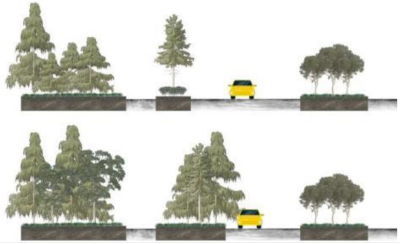 Elevation of research site A2 B2, Xianlin Ave. | |
| Beijing East Road | A3 | Rosa chinensis − Rhododendron simsii |
| B3 | Styphnolobium japonicum + Prunus serrulata − Zoysia japonica | |
| Elevation (1:300) |  Elevation of research site A3 B3, Beijing East Road. | |
| Taiping North Road | A4 | Metasequoia glyptostroboides + Carya illinoinensis + Prunus serrulata − Photinia serratifolia + Nandina domestica + Mahonia bealei |
| B4 | Osmanthus fragrans + Phyllostachys edulis + Magnolia grandiflora + Zelkova serrata + Carya illinoinensis + Prunus serrulata − Euonymus japonicus “Aurea-marginatus” + Photinia × fraseri + Loropetalum chinense var. rubrum − Ophiopogon bodinieri | |
| Elevation (1:300) | 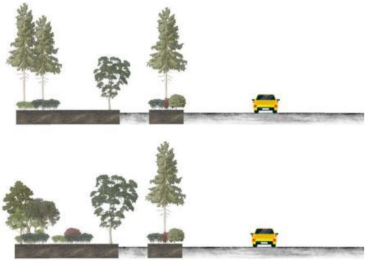 Elevation of research site A4 B4, Taiping North Road. | |
| Mengdu Street | A5 | Cinnamomum camphora + Ginkgo biloba |
| B5 | Cinnamomum camphora + Ginkgo biloba + Acer palmatum − Rhododendron simsii + Pittosporum tobira + Pittosporum tobira − Ophiopogon japonicus + Ophiopogon bodinieri | |
| Elevation (1:300) | 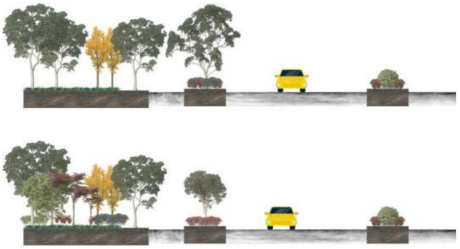 Elevation of research site A5 B5, Mengdu Street. | |
| Shuanglong Avenue | A6 | Sapindus saponaria + Prunus cerasifera f. atropurpurea + Cinnamomum camphora + Ginkgo biloba − Ophiopogon bodinieri |
| B6 | Prunus cerasifera f. atropurpurea + Ginkgo biloba + Cornus wilsoniana + Albizia julibrissin + Cinnamomum camphora − Photinia serratifolia − Ophiopogon bodinieri | |
| Elevation (1:300) | 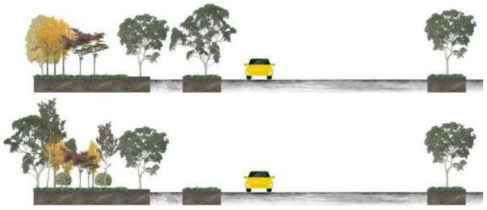 Elevation of research site A6 B6, Shuanglong Ave. | |
| Jiyin Avenue | A7 | Koelreuteria paniculata + Photinia serratifolia + Cinnamomum camphora + Platanus acerifolia |
| B7 | Koelreuteria paniculata + Osmanthus fragrans + Lagerstroemia indica + Prunus serrulata + Nerium oleander + Prunus persica − Euonymus japonicus “Aurea-marginatus” + Ligustrum × vicaryi − Ophiopogon japonicus | |
| Elevation (1:300) | 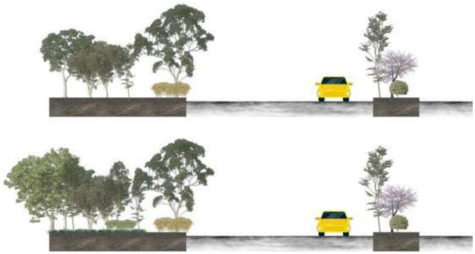 Elevation of research site A7 B7, Jiyin Ave. |
2.3. Monitoring Network and Sampling
2.4. Data Collection
2.5. Data Analysis
3. Results
3.1. Influence of Environmental Factors on Ambient PM10 and PM2.5 Concentration
3.1.1. Traffic Flow
3.1.2. Weather Factors
3.2. Spatial Distribution of PM Concentrations among Plant Communities
3.2.1. Ambient PM10 and PM2.5 Concentrations among Plant Communities at Different Distances from the Road
3.2.2. Ambient PM10 and PM2.5 Concentrations among Plant Communities at Different Heights above the Ground
3.2.3. Different Ambient PM10 and PM2.5 Concentrations among Different Plant Community Structures
3.2.4. Different Ambient PM10 and PM2.5 Concentrations among Different Arbor Species
4. Discussion
4.1. Effects of Vegetation Composition on PM Concentrations
4.2. Arbor Species and Their Effects on PM Concentrations
4.3. Influence of Meteorological Factors on Pollutant Changes
5. Conclusions
6. Limitations and Future Research
Author Contributions
Funding
Institutional Review Board Statement
Informed Consent Statement
Data Availability Statement
Conflicts of Interest
Abbreviations
References
- WHO. Air Pollution Levels Rising in Many of the World’s Poorest Cities. WHO News Release, 2016. Available online: http://www.who.int//mediacentre/news/releases/2016/air-pollution-rising/en/ (accessed on 12 May 2016).
- Akiko, M.; Yoshiki, N.; Kazuaki, T. Assessment of air quality index and health impact of PM10, PM2.5 and SO2 in Yazd, Iran. J. Maz. Univ. Med. Sci. 2015, 25, 14–23. [Google Scholar]
- Song, Y.; Maher, B.A.; Li, F.; Wang, X.; Sun, X.; Zhang, H. Particulate matter deposited on leaf of five evergreen species in Beijing, China: Source identification and size distribution. Atmos. Environ. 2015, 105, 53–60. [Google Scholar] [CrossRef]
- Baldauf, R. Roadside vegetation design characteristics that can improve local, near-road air quality. Transp. Res. D Transp. Environ. 2017, 52, 354–361. [Google Scholar] [CrossRef] [PubMed]
- Zhang, H. Atmospheric PM2.5 and PM10 Pollutions and Their Components Characteristics before and after the Youth Olympic Games and Health Risk Assessment in Nanjing City; Nanjing Agriculture University: Nanjing, China, 2016. [Google Scholar]
- Jeanjean, A.P.R.; Monks, P.S.; Leigh, R.J. Modelling the effectiveness of urbantrees and grass on PM2.5 reduction via dispersion and deposition at a cityscale. Atmos. Environ. 2016, 147, 1–10. [Google Scholar] [CrossRef]
- Ryu, J.; Kim, J.J.; Byeon, H.; Go, T.; Lee, S.J. Removal of fine particulate matter (PM2.5) via atmospheric humidity caused by evapotranspiration. Environ. Pollut. 2019, 245, 253–259. [Google Scholar] [CrossRef] [PubMed]
- Al-Dabbous, A.N.; Kumar, P. The influence of roadside vegetation barriers on airborne nanoparticles and pedestrians exposure under varying wind conditions. Atmos. Environ. 2014, 90, 113–124. [Google Scholar] [CrossRef]
- Sheng, Q.Q.; Zhang, Y.L.; Zhu, Z.L. Study to quantify road greenbelts and their association with PM2.5 concentration along city main roads in Nanjing, China. Sci. Total Environ. 2019, 667, 710–717. [Google Scholar] [CrossRef]
- Chen, L.X.; Liu, C.M.; Zou, R.; Yang, M.; Zhang, Z.Q. Experimental examination of effectiveness of vegetation as bio-filter of particulate matters in the urban environment. Environ. Pollut. 2016, 208 Pt A, 198–208. [Google Scholar] [CrossRef]
- Xiaogang, W.U.; Lin, Y. Impact of plant configuration mode of greening segregating belt on air quality of adjacent sidewalk in urban street. Acta Sci. Circum. 2015, 35, 984–990. [Google Scholar]
- Pope, C.A.; Burnett, R.T.; Thun, M.J.; Calle, E.E.; Krewski, D.; Ito, K.; Thurston, G.D. Lung cancer, cardiopulmonary mortality, and long-term exposure to fine particulate air pollution. JAMA 2002, 287, 1132–1141. [Google Scholar] [CrossRef]
- Institute for Health Metrics and Evaluation. Global Burden of Disease (GBD), 2014. Available online: http://www.healthdata.org/gbd (accessed on 3 September 2014).
- Zhang, M.; Zhu, B.; Wang, D.D.; Zhou, S.Q. Characteristics of SO2, NO2 and O3 over north suburb of Nanjing in winter. Trans. Atmos. Sci. 2009, 32, 695–702. [Google Scholar] [CrossRef]
- Li, R.; Wang, X. Effect of precipitation on Air pollution in Urumqi City. J. Desert Oasis Meteorol. 2007, 2, 13–15. [Google Scholar]
- Zhang, B.; Wang, W.J.; He, X.Y.; Zhou, W.; Xiao, L.; Lv, H.L.; Wei, C. Shading, cooling and humidifying effects of urban forests in Harbin City and possible association with various factors. Chin. J. Ecol. 2017, 36, 951–961. (In Chinese) [Google Scholar]
- Carslaw, D.C.; Murrells, T.P.; Andersson, J.; Keenan, M. Have vehicle emissions of primary NO2 peaked? Faraday Discuss. 2016, 189, 439–454. [Google Scholar] [CrossRef]
- Zheng, Y.F.; Tang, X.Y.; Xu, J.Q.; Zhang, H.; Yang, L.; Bai, X. The analysis of precipitation acidity and chemical composition in the industrial estate located on North Bank of the Yangtze River, Nanjing. Res. Environ. Sci. 2007, 4, 45–51. [Google Scholar] [CrossRef]
- Shi, Y.Z.; An, J.L.; Wang, H.L.; Zou, J.A.; Wang, J. Distribution characteristics of water soluble ions under different weather conditions during the youth Olympic Games in Nanjing. Environ. Sci. 2016, 37, 4475–4481. [Google Scholar] [CrossRef]
- Zhang, Z.; Lv, Y.M.; Pan, H.T. Cooling and humidifying effect of plant communities in subtropical urban parks. Urban For. Urban Green. 2013, 12, 323–329. [Google Scholar] [CrossRef]
- Shao, F.; Wang, L.; Sun, F.; Li, G.; Yu, L.; Wang, Y.; Zeng, X.; Yan, H.; Dong, L.; Bao, Z. Study on different particulate matter retention capacities of the leaf surfaces of eight common garden plants in Hangzhou, China. Sci. Total Environ. 2019, 652, 939–951. [Google Scholar] [CrossRef]
- Nowak, D.J.; Hirabayashi, S.; Bodine, A.; Hoehn, R. Modeled PM2.5 removal by trees in ten U.S. Cities and associated health effects. Environ. Pollut. 2013, 178, 395–402. [Google Scholar] [CrossRef]
- Popek, R.; Przybysz, A.; Gawrońska, H.; Klamkowski, K.; Gawroński, S.W. Impact of particulate matter accumulation on the photosynthetic apparatus of roadside woody plants growing in the urban conditions. Ecotoxicol. Environ. Saf. 2018, 163, 56–62. [Google Scholar] [CrossRef]
- Przybysz, A.; Nersisyan, G.; Gawroński, S.W. Removal of particulate matter and trace elements from ambient air by urban greenery in the winter season. Environ. Sci. Pollut. Res. Int. 2019, 26, 473–482. [Google Scholar] [CrossRef] [PubMed]
- Viippola, V.; Whitlow, T.H.; Zhao, W.L.; Yli-Pelkonen, V.; Mikola, J.; Pouyat, R. The effects of trees on air pollutant levels in peri-urban near-road environments. Urban For. Urban Green. 2018, 30, 62–71. [Google Scholar] [CrossRef]
- Yli-Pelkonen, V.; Setälä, H.; Viippola, V. Urban forests near roads do not reduce gaseous air pollutant concentrations but have an impact on particles levels. Landsc. Urban Plan. 2017, 158, 39–47. [Google Scholar] [CrossRef]
- Mori, J.; Fini, A.; Galimberti, M.; Ginepro, M.; Burchi, G.; Massa, D. Air pollution deposition on a roadside vegetation barrier in a Mediterranean environment: Combined effect of evergreen shrub species and planting density. Sci. Total Environ. 2018, 643, 25–737. [Google Scholar] [CrossRef] [PubMed]
- Liu, X.H.; Yu, X.X.; Zhang, Z.M. PM2.5 Concentration Differences between various forest types and its correlation with forest structure. Atmosphere 2015, 6, 1801–1815. [Google Scholar] [CrossRef]
- Li, X.Y.; Zhao, S.T.; Guo, J.; Li, Y.M. Effects of different plant communities in urban park green spaces on fine particles removal and its key factors. Chin. Landsc. Archit. 2016, 8, 10–13. [Google Scholar]
- Jim, C.Y.; Chen, W.Y. Assessing the ecosystem service of air pollutant removal by urban trees in Guangzhou (China). J. Environ. Manag. 2008, 88, 665–676. [Google Scholar] [CrossRef]
- Petroff, A.; Mailliat, A.; Amielh, M.; Anselmet, F. Aerosol dry deposition on vegetative canopies. Part I: Review of present knowledge. Atmos. Environ. 2008, 42, 3625–3653. [Google Scholar] [CrossRef]
- Zhao, Y.Y.; Hu, Q.W.; Li, H.D.; Wang, S.H.; Ai, M.Y. Evaluating carbon sequestration and PM2.5 removal of urban street trees using mobile laser scanning data. Remote Sens. 2018, 10, 1759. [Google Scholar] [CrossRef]
- Chen, L.X.; Liu, C.M.; Zhang, L.; Zou, R.; Zhang, Z.Q. Variation in tree species ability to capture and retain airborne fine particulate matter (PM2.5). Sci. Rep. 2017, 7, 3206. [Google Scholar] [CrossRef]
- Li, X.Y.; Zhao, S.T.; Li, Y.M.; Guo, J.; Li, W. Subduction effect of urban arteries green space on atmospheric concentration of PM2.5 in Beijing. J. Ecol. Environ. 2014, 23, 615–621. [Google Scholar]
- Sæbø, A.; Popek, R.; Nawrot, B.; Hanslin, H.M.; Gawronska, H.; Gawronski, S.W. Plant species differences in particulate matter accumulation on leaf surfaces. Sci. Total Environ. 2012, 427–428, 347–354. [Google Scholar] [CrossRef] [PubMed]
- Balczó, M.G.; Gromke, C.; Ruck, B. Numerical modeling of flow and pollutant dispersion in street canyons with tree planting. Meteorol. Z. 2009, 18, 197–206. [Google Scholar] [CrossRef]
- Popek, R.; Gawrońska, H.; Wrochna, M.; Gawroński, S.W.; Saebø, A. Particulate matter on foliage of 13 woody species: Deposition on surfaces and phytostabilization. Int. J. Phytoremediation 2013, 15, 245–256. [Google Scholar] [CrossRef]
- Baraldi, R.; Neri, L.; Costa, F.; Facini, O.; Rapparini, F.; Carriero, G. Ecophysiological and micromorphological characterization of green roof vegetation for urban mitigation. Urban For. Urban Green. 2019, 37, 24–32. [Google Scholar] [CrossRef]
- Mori, J.; Hanslin, H.M.; Burchi, G.; Sæbø, A. Particulate matter and element accumulation on coniferous trees at different distances from a highway. Urban For. Urban Green. 2015, 14, 170–177. [Google Scholar] [CrossRef]
- Przybysz, A.; Sæbø, A.; Hanslin, H.M.; Gawroński, S.W. Accumulation of particulate matter and trace elements on vegetation as affected by pollution level, rainfall and the passage of time. Sci. Total Environ. 2014, 481, 360–369. [Google Scholar] [CrossRef]
- Mori, J.; Sæbø, A.; Hanslin, H.M.; Teani, A.; Ferrini, F.; Fini, A. Accumulation of traffic related air pollutants on leaves of six evergreen shrub species during Mediterranean summer season. Urban For. Urban Green. 2015, 14, 264–273. [Google Scholar] [CrossRef]
- Nowak, D.J.; Crane, D.E.; Stevens, J.C. Air pollution removal by urban trees and shrubs in the United States. Urban For. Urban Green. 2006, 4, 115–123. [Google Scholar] [CrossRef]
- Chang, Y.M.; Yan, P.B.; Yang, J. Suggestion on tree species selection for urban greening in Beijing to control PM2.5 pollution. Chin. Landsc. Archit. 2015, 31, 69–73. [Google Scholar]
- Tiwari, S.; Hopke, P.K.; Pipal, A.S.; Srivastava, A.K.; Bisht, D.S.; Tiwari, S.; Singh, A.K.; Soni, V.K.; Attri, S.D. Intra-urban variability of particulate matter (PM2.5 and PM10) and its relationship with optical properties of aerosols over Delhi, India. Atmos. Res. 2015, 166, 223–232. [Google Scholar] [CrossRef]
- Liu, J.; Zhu, L.; Wang, H.; Yang, Y.; Liu, J.; Qiu, D.; Ma, W.; Zhang, Z.; Liu, J. Dry deposition of particulate matter at an urban forest, wetland and lake surface in Beijing. Atmos. Environ. 2016, 125, 78–187. [Google Scholar] [CrossRef]
- Wu, Y.; Chen, R.M.; Wang, J.; Liu, X.F. Analysis of temporal variation characteristics and meteorological conditions of PM10 and PM2.5 in the South-Central of Hebei Province in 2013. Meteorol. Environ. Sci. 2015, 38, 68–75. (In Chinese) [Google Scholar]
- Xun, W.J.; Xu, M.M.; Liu, X.F.; Zhu, F.Q. Research on Relevance between light, Atmospheric temperature and Atmospheric Humidity in Forests. Comput. Knowl. Technol. 2017, 13, 208–211. [Google Scholar]
- Zhu, C.Z.; Zhang, R.X.; Fang, H.J.; Zhao, Q.X.; Hou, H.Q. Study on the Reaction Mechanism of chlorobenzene with Nitrous Acid in Atmospheric Aqueous Phases Initiated by Irradiation of 355 nm UV Light. Acta Phys. Chim. Sin. 2005, 4, 367–371. [Google Scholar]
- Liang, T.Z.; Liu, J. Investigation on the influence of spatial temperature on ventilation and pollutants distribution in street canyon. Build. Sci. 2019, 35, 108–115. [Google Scholar]
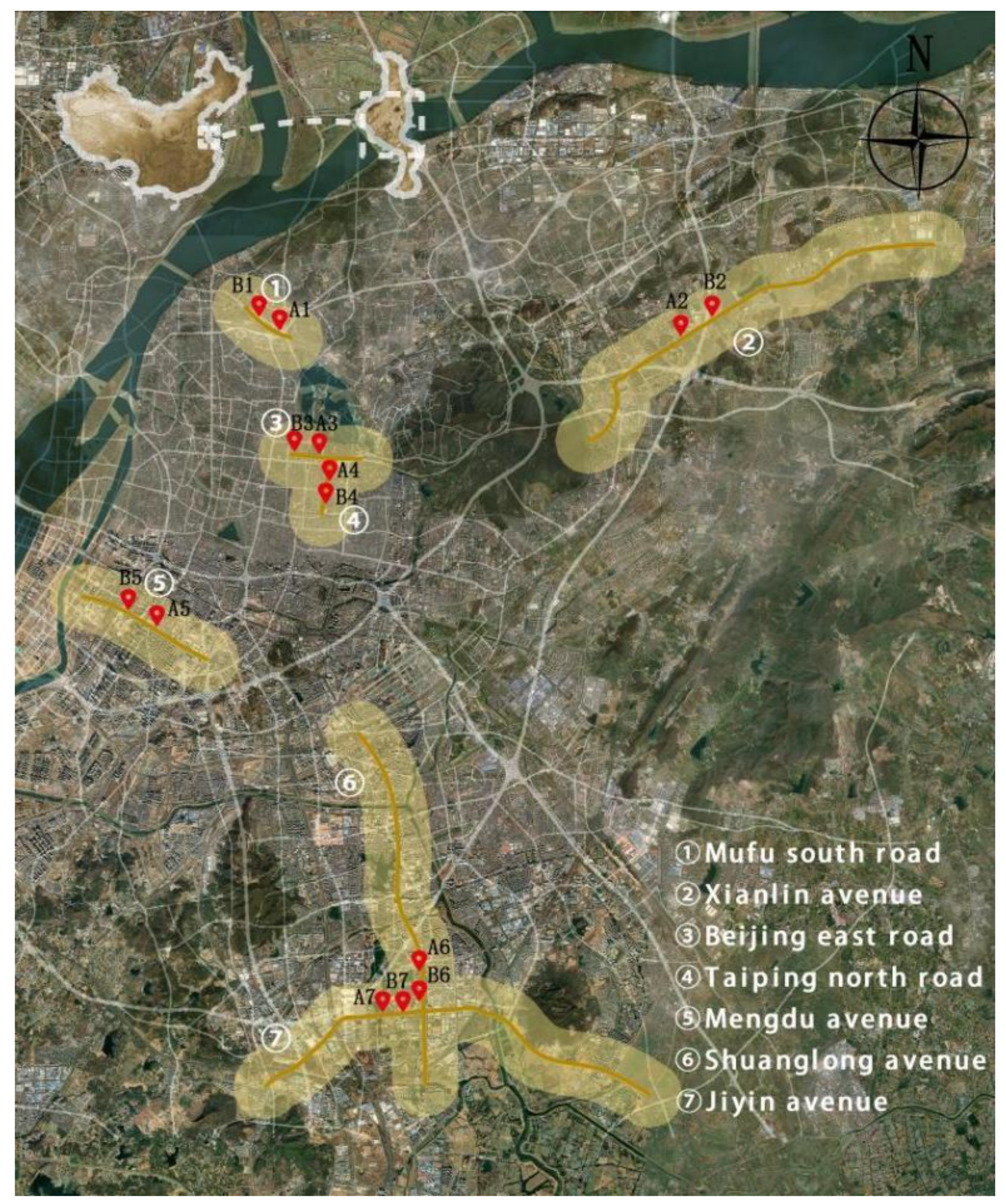

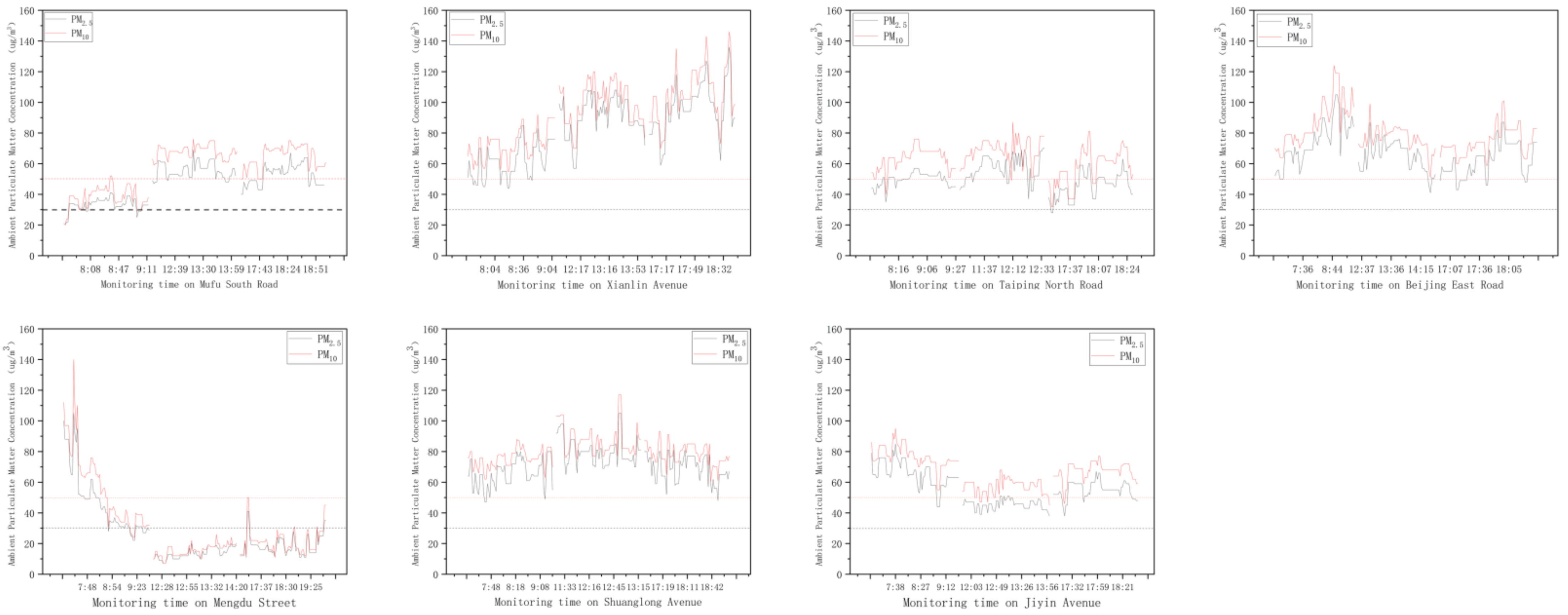
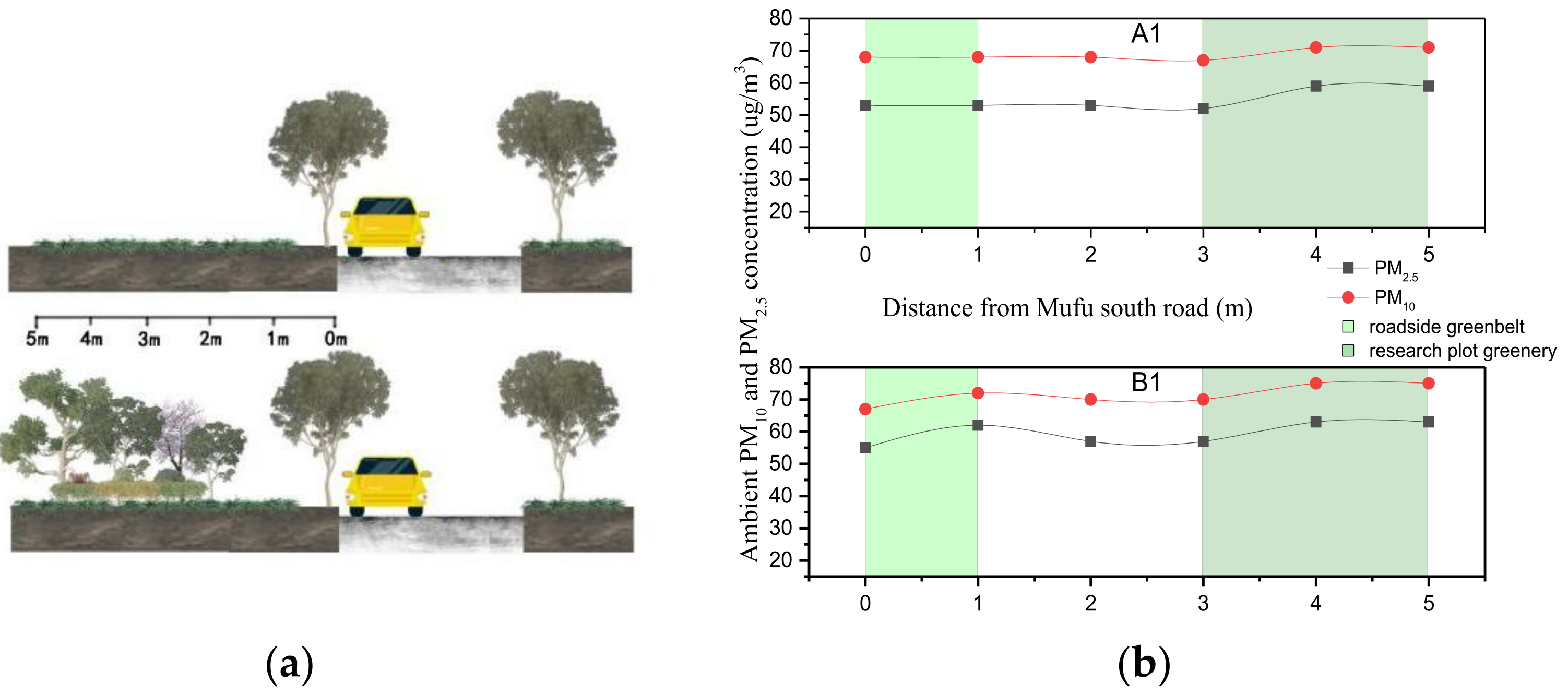


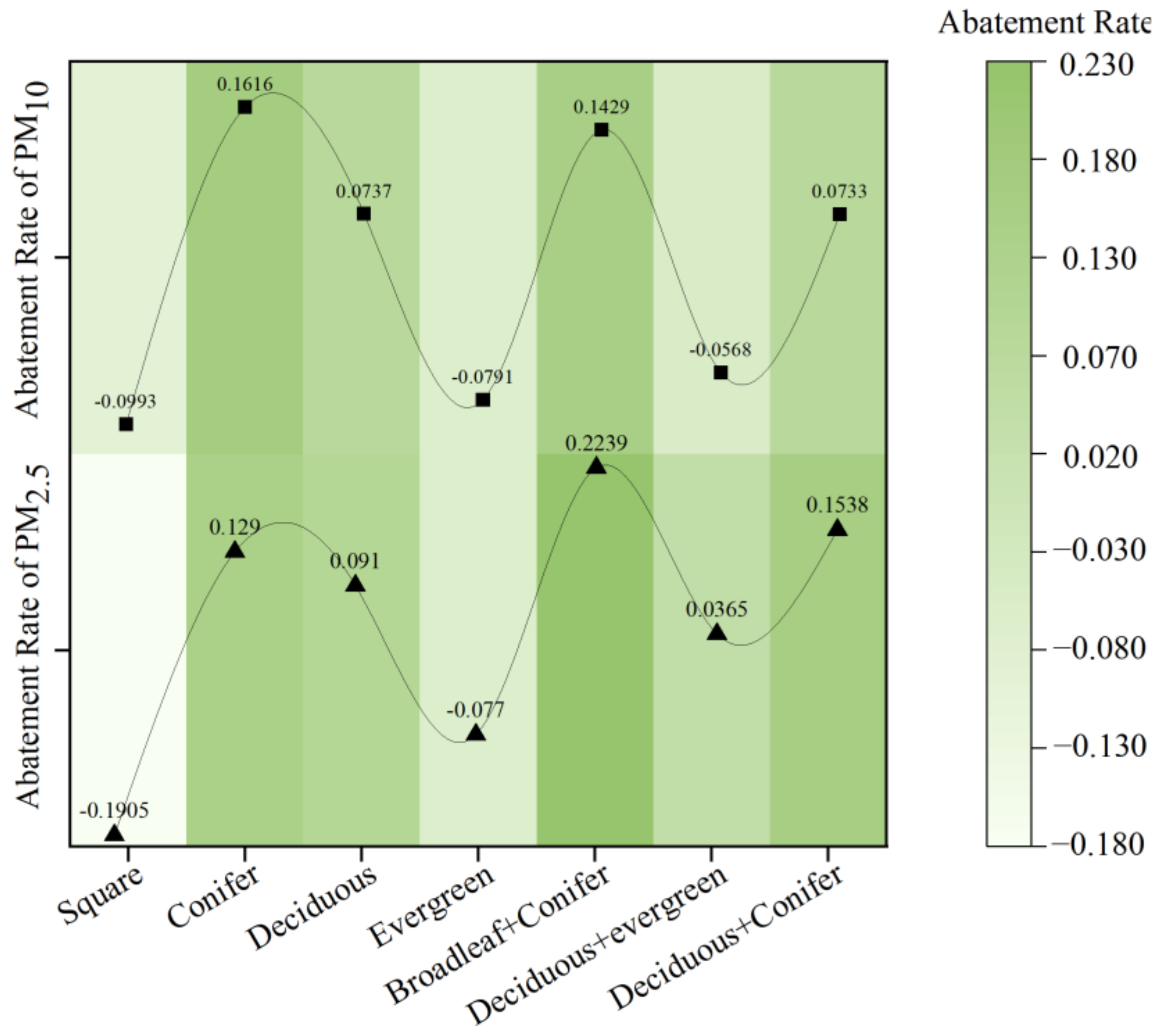
| Testing Content | Measurement Range | Resolution Ratio | Precision | Testing Content | Measurement Range | Resolution Ratio | Precision |  |
| PM2.5 | 0–1000 μg/m3 | 1 μg/m3 | ±10 μg/m3 | PM10 | 0–1000 μg/m3 | 1 μg/m3 | ±10 μg/m3 | |
| NO2 | 0–100 ppm | 0.01 ppm | ≤±3% | O3 | 0–100 ppm | 0.01 ppm | ≤±3% | |
| Temperature | −40–80 °C | 0.1 °C | ±2 °C | Relative humidity | 0–100%RH | 0.1%RH | ±2%RH | |
| Wind speed | 0–60 m/s | 0.1 m/s | ±0.5 m/s | Atmospheric pressure | 300–1200 hpa | 1 pa | ±1.5 hpa | |
| Radiation | 0–2000 μw/cm2 | 1 | ±1 μw/cm2 | Illumination | 0–300 KLux | 0.1 KLux | ±0.1 KLux | |
| Noise | 30–120 dB | 0.1 dB | <2% | |||||
| Street | Traffic Flow | ||
|---|---|---|---|
| Morning | Noon | Evening | |
| Mufu South Road | 40/5 min | 41/5 min | 64/5 min |
| Xianlin Avenue | 91/5 min | 69/5 min | 164/5 min |
| Taiping North Road | 120/5 min | 40/5 min | 62/5 min |
| Beijing East Road | 88/5 min | 62/5 min | 89/5 min |
| Mengdu Street | 97/5 min | 100/5 min | 117/5 min |
| Shuanglong Avenue | 206/5 min | 101/5 min | 170/5 min |
| Jiyin Avenue | 140/5 min | 41/5 min | 76/5 min |
| Road | Pollutant | Temperature/°C | Relative Humidity | Wind Speed/m/s | Atmospheric Pressure/pa | Atmospheric Radiation/uw/cm2 | Light Radiation/Lux | Noise/DB |
|---|---|---|---|---|---|---|---|---|
| Beijing East Road | PM2.5 | 0.365 * | 0.300 | 0.214 | −0.106 | 0.028 | −0.027 | 0.034 |
| PM10 | −0.405 * | −0.319 * | −0.145 | 0.203 | −0.083 | 0.095 | −0.044 | |
| Mufu South Road | PM2.5 | 0.316 * | −0.012 | 0.011 | 0.365 ** | −0.261 | 0.355 * | −0.130 |
| PM10 | −0.432 ** | 0.001 | 0.147 | −0.322 | 0.253 | −0.312 * | 0.173 | |
| Taiping North Road | PM2.5 | 0.031 | 0.479 ** | 0.357 * | −0.424 ** | 0.146 | −0.173 | 0.072 |
| PM10 | −0.172 | −0.603 ** | −0.238 | 0.256 | −0.162 | 0.187 | −0.024 | |
| Jiyin Avenue | PM2.5 | 0.348 ** | 0.437 ** | 0.156 | 0.220 | 0.311 * | −0.310 * | 0.412 ** |
| PM10 | −0.255 * | −0.422 ** | −0.053 | −0.111 | −0.347 ** | 0.339 ** | −0.413 ** | |
| Shuanglong Avenue | PM2.5 | −0.043 | 0.004 | −0.161 | −0.185 | 0.118 | −0.141 | 0.004 |
| PM10 | 0.013 | −0.036 | 0.228 | 0.253 * | −0.114 | 0.128 | −0.006 | |
| Mengdu Street | PM2.5 | −0.334 ** | −0.128 | 0.127 | 0.017 | 0.246 | −0.257 * | 0.297 * |
| PM10 | 0.268 * | 0.244 | 0.023 | −0.219 | −0.341 ** | 0.357 ** | −0.129 | |
| Xianlin Avenue | PM2.5 | 0.108 | 0.082 | −0.004 | −0.217 | 0.122 | −0.177 | −0.135 |
| PM10 | −0.145 | −0.092 | 0.115 | 0.204 | −0.063 | 0.132 | 0.124 |
| Plant Communities | PM2.5 (ug/m3) | PM10 (ug/m3) | |
|---|---|---|---|
| Beijing East Road A3 (CK) | Square | −19.05% | −9.93% |
| Mufu South Road plot A1 | Lawn | −11.32% | −4.41% |
| Jiyin Avenue plot A7 | Arbor | 10.86% | 12.28% |
| Jiyin Avenue plot B7 | Arbor + shrub | 15.68% | 19.11% |
| Beijing East Road B3 | Arbor + grass | 15.19% | 9.41% |
| Taiping North Road plot B4 | Arbor + shrub + grass | 22.39% | 14.29% |
| Arbor Species | PM2.5 (ug/m3) | PM10 (ug/m3) | |
|---|---|---|---|
| Beijing East Road A3 (CK) | Square | −19.05% | −9.93% |
| Xianlin Avenue Road plot A2 | Conifer arbor | 12.90% | 16.16% |
| Shuanglong Avenue plot A6 | Deciduous arbor | 9.10% | 7.37% |
| Mufu South Road plot B1 | Evergreen arbor | −7.70% | −7.91% |
| Taiping North Road plot B4 | Broadleaf + conifer arbor | 22.39% | 14.29% |
| Shuanglong Avenue plot B6 | Deciduous + evergreen arbor | −3.65% | −5.68% |
| Taiping North Road plot A4 | Deciduous + conifer arbor | 15.38% | 7.33% |
Disclaimer/Publisher’s Note: The statements, opinions and data contained in all publications are solely those of the individual author(s) and contributor(s) and not of MDPI and/or the editor(s). MDPI and/or the editor(s) disclaim responsibility for any injury to people or property resulting from any ideas, methods, instructions or products referred to in the content. |
© 2022 by the authors. Licensee MDPI, Basel, Switzerland. This article is an open access article distributed under the terms and conditions of the Creative Commons Attribution (CC BY) license (https://creativecommons.org/licenses/by/4.0/).
Share and Cite
Liu, C.; Dai, A.; Ji, Y.; Sheng, Q.; Zhu, Z. Effect of Different Plant Communities on Fine Particle Removal in an Urban Road Greenbelt and Its Key Factors in Nanjing, China. Sustainability 2023, 15, 156. https://doi.org/10.3390/su15010156
Liu C, Dai A, Ji Y, Sheng Q, Zhu Z. Effect of Different Plant Communities on Fine Particle Removal in an Urban Road Greenbelt and Its Key Factors in Nanjing, China. Sustainability. 2023; 15(1):156. https://doi.org/10.3390/su15010156
Chicago/Turabian StyleLiu, Congzhe, Anqi Dai, Yaou Ji, Qianqian Sheng, and Zunling Zhu. 2023. "Effect of Different Plant Communities on Fine Particle Removal in an Urban Road Greenbelt and Its Key Factors in Nanjing, China" Sustainability 15, no. 1: 156. https://doi.org/10.3390/su15010156
APA StyleLiu, C., Dai, A., Ji, Y., Sheng, Q., & Zhu, Z. (2023). Effect of Different Plant Communities on Fine Particle Removal in an Urban Road Greenbelt and Its Key Factors in Nanjing, China. Sustainability, 15(1), 156. https://doi.org/10.3390/su15010156






